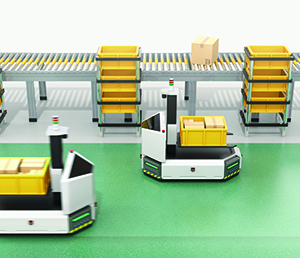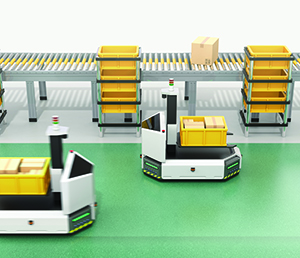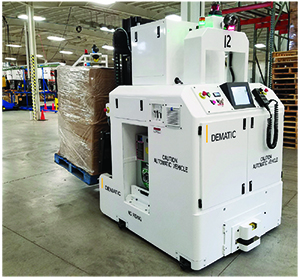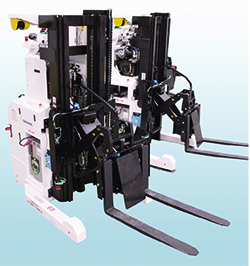- By Bill Lydon
Summary
Fast Forward
- AGVs increase work-in-process throughput.
- Modern AGVs can be part of a flexible manufacturing strategy.
- Modern AGVs become part of a synchronized manufacturing system directed by ERP or MES.

Technological advances bring greater flexibility
By Bill Lydon

The advancement of navigation technologies has been an essential contributor to the increased use of AGVs. There are many types of AGV navigation technologies, but some are now less frequently used. AGV manufacturers generally consider the four following technologies for new equipment and installation.
Magnetic navigation
Magnetic navigation for various light-duty AGVs typically uses magnetic tape for the guide path. One major advantage of using tape instead of wired guidance is that it can be easily removed and relocated if the course needs to change. It also removes the expense involved in restructuring the floor of the factory or warehouse. A limitation of this method is that the routes have to be fixed and well defined by the tape. If any obstacle is detected in front of the AGV, it stops and waits for the problem to be solved (e.g., the obstacle to be removed) before it restarts.
Laser-guided navigation
Laser-guided navigation is similar to an electronic eye. By means of reflectors positioned on the surrounding walls, the vehicle uses triangulation to determine its exact position, so it can carry out the required tasks in the operating area. The advantage of laser-guided technology is that it requires no floor work, as in the case of magnetic guidance systems. Additionally, route changes can be made easily via software updates to ensure maximum flexibility for company logistics.
Vision-guided vehicles
Vision-guided vehicles (VGVs) use optic sensors (cameras), in addition to other sensors, such as speed or laser sensors, to navigate. Software within the vehicle effectively builds a 3D map of its operating environment.
This technology allows the vehicles to operate in automatic or manual mode for great
flexibility.
Natural navigation
AGVs based on natural navigation technology do not require reflectors or markers, so they require less installation time and are easily integrated into existing systems. This minimizes the impact on current operations. In this type of navigation, LiDAR (light detection and ranging) is the main technology used.
Applying AGVs
Today AGVs come in all shapes and sizes. They have the capability to carry a range of items, from lightweight parts to large heavy loads like a complete engine. Typical applications include:
Work-in-process movement
Work-in-process (WIP) movement was one of the first applications where automated guided vehicles were used. It includes the repetitive movement of materials throughout the manufacturing process. AGVs can be used to move material from the warehouse to production/processing lines or from one process to another. Today AGVs are coupled with enterprise and plant production computer systems, so they can operate synchronized with manufacturing orders and production flow requirements.
Production parts delivery
AGVs deliver parts to machines and workstations based on production plans and real-time operations feedback to keep production flowing.
Pallet handling
Pallet handling is an extremely popular application for AGVs, because repetitive movement of pallets is very common in manufacturing and distribution facilities. AGVs can move pallets from the palletizer to stretch wrapping to the warehouse or to the outbound shipping docks.
Finished product handling
Moving finished goods from manufacturing to storage or shipping is the final movement of materials before they are delivered to customers. These movements often require the gentlest material handling, because the products are complete and can be damaged from rough handling. AGVs operate with precisely controlled navigation and acceleration and deceleration, minimizing the potential for damage and making them an excellent choice for this type of application.
Trailer loading
Automatically loading trailers is a relatively new and increasingly popular application for automated guided vehicles. AGVs are used to transport and load pallets of finished goods directly into standard, over-the-road trailers without any special dock equipment. AGVs can pick up pallets from conveyors, racking, or staging lanes and deliver them into the trailer in the specified loading pattern. Some automatic trailer-loading AGVs use analytics software coupled with vision systems to view the walls of the trailer for navigation and coordinated trailer loading based on delivery routes.

AGVs now?
Automated guided vehicles have advanced technologically, and there are a number of advantages to automating using them to improve manufacturing operations. Advanced methods, such as laser navigation technology of the AGVs, help both avoid the requirement for in-floor wires (making them highly flexible with easily changed paths) and expand the system quickly without infrastructure investments. These new systems that are software directed allow an AGV with a problem to be replaced quickly with another unit.
Automated material handling technology can provide manufacturers many obvious and measurable benefits, such as decreased operating costs and increased throughput of materials, but they can be extended further.
Safety
Process safety is improved by eliminating the threat of people with handcarts. The manager at a large company that deployed AGVs told me it has reduced damage done by human-operated forklifts. Over time they have determined that the AGVs reduced product and facility damage.
Material traceability
Material traceability is automatically synchronized and tracked electronically with ERP systems-improving productivity, predictability, and consistency of material handling efforts at a reduced cost.
Manufacturing KPIs
Deploying AGVs connected in real-time with information systems in the plant provides immediate visibility of material and work-in-process flows and a record for accurate key performance indicators (KPIs).
Increased labor productivity
Delivering materials and work in process to the exact spot where they are needed saves the time required for personnel to retrieve materials from inventory locations. Manual material movement is not a high value-added activity. By applying AGVs, manufacturing employees have the materials and work in process when required, increasing productivity. Flexibility to alter the flow based on changing requirements allows employees to be repositioned to higher-value roles that require more specialized skills or the ability to handle complex tasks.
Lower work-in-process time
Using AGVs, work-in-process time can be lowered. This increases manufacturing throughput and contributes to better delivery performance, increasing profitability and customer satisfaction.

Just-in-time production
In highly flexible manufacturing applications where a synchronized production line is not practical, AGVs deliver parts for production orders to machines or manual workstations just in time-synchronized with production flow. The AGVs can also move the work and process to the appropriate machines or workstations in sequence. This approach leverages investments already made in ERP and MES. This can also be coordinated with companies applying 5S, a Japanese method to organize a work space for efficiency and effectiveness by identifying and storing the items used, maintaining the area and items, and sustaining the new order.
In applications with particularly high variability, operators use smartphone-sized wireless handheld computers with a bar-code reader connected to the ERP system and linked to the warehouse management system. The operator simply scans a manufacturing order, his or her work center ID\, and bill of materials for the order. The system will then deliver the materials to the workstation.
Application examples
I had a discussion with a manager at a company that implemented automated guided vehicles to improve operations at manual workstations. The company implemented the Lean 5S method of workplace organization. The location of everything in the workspace was defined and clearly marked, and this ensured the efficient use of AGVs. The AGV was programmed to arrive at the workstation and stop, allowing the operator to take the required materials that it was delivering. If the workplaces were not organized in an orderly fashion, the workflow could be easily interrupted, as an AGV makes an automatic safety stop if something is in its programmed path.
The overall project goal was the implementation of a quality, systems-controlled, pull process that enabled more efficient retrieval and delivery of materials to work centers, enhancing production flow. The solution used AGVs that were directed based on production flow. The ERP system scheduled them to minimize repetitive material movements to and from the points of use. This approach met the flexibility required by the high variability of order types. There are a number of advantages cited using this approach:
- ensures correct material and batch deliveries to workstations
- delivers real-time traceable materials to workstations
- provides end-of-order reconciliation based on actual consumption
The results have been annual recurring savings due to vehicle automation and process simplification. The savings have been more than $5 million a year, at more than 40 sites.
I had the opportunity to tour the Detroit Diesel manufacturing plant in Redford Township, Mich. Detroit Diesel has made significant improvements to enhance its manufacturing. The flexible diesel engine production line is deployed using heavy-duty AGVs that each move a large engine block to workstations. The engine block is mounted so that it can be rotated for assembly operations by personnel. This setup was also part of implementing the Lean 5S method.

Reader Feedback
We want to hear from you! Please send us your comments and questions about this topic to InTechmagazine@isa.org.

